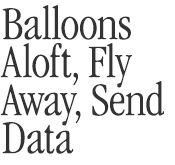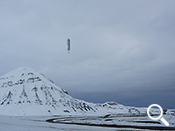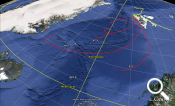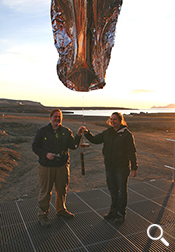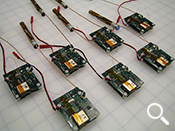
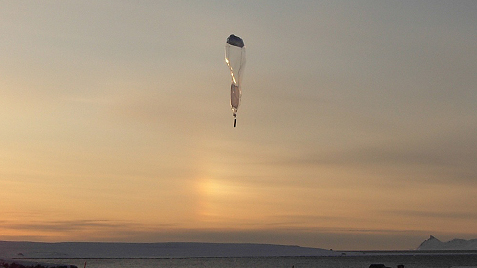
Are drones the new way of the future for research scientists? Smith engineering professor Paul Voss would like to think so. He hopes to expand his research from remotely operated balloons with top-notch sensors into unmanned aircraft systems, also known as drones, but FAA rules make it difficult to get proper permissions. In 2007, Voss and his students launched a balloon in the Arctic from the Ny-Ålesund research station on the Svalbard archipelago. Photo by Lars Hole, senior scientist, Meteorological Institute of Norway.
/ Published August 16, 2013
The sky is the limit for researchers like Paul Voss, associate professor of engineering, who works on figuring out ways to put sensors in flight to track airborne toxins and collect meteorological data.
Voss’s research so far centers on the use of remotely operated high-tech balloons. In his Ford Hall Atmospheric Research Lab, Voss and his students develop ever lighter and more versatile equipment to measure and monitor weather patterns and pollutants. He has joined teams collecting data from pollution plumes emanating from New York City and Mexico City (see NewsSmith Winter 2006). Most recently he deployed balloons to the Arctic and Antarctica to study weather and climate.
Responding to a research need, Voss invented an efficient way to give balloons a special and highly useful property—the remote-controlled ability to go up and down to specified altitudes. He embedded a small high-strength balloon (pressurized with helium) and a lightweight compressor inside a larger balloon. To make the whole system rise, the operator sends a signal to release the gas, from what is essentially serving as a tank, into the larger chamber. To make the system lose altitude, the pump compresses the helium into the smaller balloon, thereby decreasing the overall buoyancy.
The system works, says Voss, because the pressure inside the smaller balloon stays constant as the system gains or loses altitude. During the initial concept development, it was a surprise that the physics worked out so favorably in this respect. “It means that a balloon using this system can access a wide range of altitudes very efficiently,” he says.
In the winter (which is summer in the Southern Hemisphere) of 2012, Voss collaborated with Lars Hole, senior scientist at the Norwegian Meteorological Institute, on an expedition that incorporated Voss’s technology to gather data on wind, temperature and humidity patterns in Antarctica. The remote and forbidding region poses special challenges to researchers trying to understand how climate change will influence ice sequestered at the poles.
A year later, Voss extended his research at a reduced cost by mailing his balloons to scientists already on the ground in Antarctica, who released them. From his Northampton office, Voss could control and collect data from the balloons. “We went down there and got everything working—now we can do the same research at much lower cost and with far less environmental impact,” he says.
Voss sent and received signals from his balloons in the Southern Hemisphere through satellite links that reach anywhere in the world. Wind currents dictated the path, but Voss determined the altitude, giving him a unique ability to get temperature, humidity, wind speed and air pressure readings all the way from ground level (“we put it down and let it ski on the surface”) to 10,000 feet up.
Each balloon has an onboard microprocessor that controls its motion, says Voss. “We don’t tell the balloon to go up or down, instead we send a command to go to a certain altitude.” The onboard microprocessor then controls the compressor and valve, guiding the balloon to the desired altitude automatically, explains Voss.
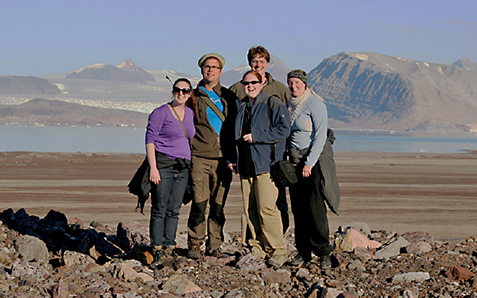
The research team for the Arctic balloon study in August 2010 (left to right): Helen Johnston ’12, Lars Hole (senior scientist, Meteorological Institute of Norway), Elizabeth Helbling ’12, Paul Voss and Anniken Mentzoni (MSc student, University of Oslo).
Voss brought the balloons to maximum and minimum altitude approximately once in each of the four-and-a-half days the experiment lasted, giving climatologists information on “how the atmosphere is evolving over time.” This is crucial for testing the reliability of existing models, says Voss, “getting ground truth, they call it.” The data go from the balloon to a satellite, which relays it to Voss in the form of an email attachment.
More than a third of Voss’s laboratory in Ford Hall is devoted to electronics and programming as part of the challenge to develop lighter instrument payloads that yield more robust data. He and his students design the custom circuit boards that are then fabricated by a manufacturing company and populated with miniature chips—by hand—back in his research lab.
Unmanned Aircraft Systems Offer Both Possibility and Challenge
Voss has been expanding his research from balloons into unmanned aircraft systems (UAS), commonly known as “drones.” Small models can be used to collect atmospheric data near the ground, test new sensors and instruments, and even teach aeronautics. But Voss is concerned about what he sees as a murky regulatory framework governing this experimentation.
“Unfortunately, these fascinating flying contraptions have become so heavily regulated by the Federal Aviation Authority,” Voss notes, “that it is not even clear if researchers can fly a paper airplane outdoors without approval from federal authorities.” This lack of clarity puts U.S. scientists, engineers and entrepreneurs at a competitive disadvantage to their counterparts overseas, he adds.
Scientists have begun using UAS in many areas, like agriculture, wildlife monitoring and law enforcement, says Voss. Farmers in Japan, for instance, are leaders in deploying UAS to collect daily high-resolution images of their crops. They can see where weeds are sprouting up or insects are appearing and can then target them to administer small doses of agricultural chemicals with great precision. “If you have an outbreak of a certain pest situation, you can hit it early on and use a lot less pesticide to knock it out before it spreads,” says Voss, “so it has economic benefits and environmental benefits too.”
Drones used in this way “are by far the greenest aircraft ever invented,” according to Voss. “They run on tiny batteries and can be recharged on a small solar panel, compared with many gallons of leaded aviation fuel burned for even the shortest manned aircraft flight.”
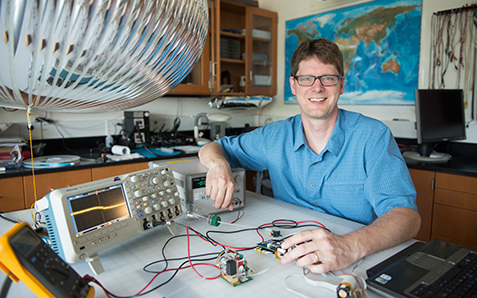
Paul Voss
Biologists can use unmanned aircraft systems to track wildlife in remote areas, giving them a better and faster picture of where animals are moving. They can also monitor forest health. Meteorologists are using drones to improve forecasts and collect data that, in aggregate, will help predict the likelihood of tornados.
Voss is actively engaged in clarifying how the FAA intends to regulate drones. In the past year he has shifted his focus to airspace law and how it pertains to unmanned aircraft, challenging policies that he says extend federal jurisdiction from approximately 400 feet above the ground, established by legal precedent, down to ground level. In May he presented a conference paper titled “Rethinking the Regulatory Framework for Small Unmanned Aircraft” at the 2013 International Conference on Unmanned Aircraft Systems in Atlanta. In July the Northampton City Council passed a resolution, which Voss helped draft, linking concern over weaponized drones to issues he has raised over FAA airspace policies. “There are some very serious restrictions that come with the public airspace....our backyards are being defined away from us,” he said in a recent article in the Daily Hampshire Gazette.
Voss hopes his policy work will enable him to get back to his primary interest in aerial vehicle design and environmental measurements without having to worry about running afoul of federal law. The technology for building and flying model aircraft has been in use since the 1930s, he says. “It has been part of academic research and engineering education for almost a century and has by far the best safety record of anything in the air.” Designing and operating these tiny aircraft are really exciting for students, he continues. “It involves mathematics, fluid mechanics, structural design, electronics, programming and control theory. It is a microcosm of engineering.”














